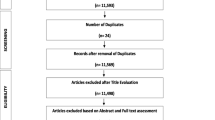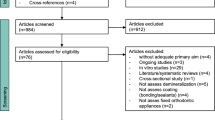Abstract
Scope and purpose
The guideline aims to address four clinical questions relating to the use of pit and fissure sealants:
-
Under what circumstances should sealants be placed to prevent caries?
-
Does placing sealants over early (noncavitated) lesions prevent progression of the lesions?
-
Are there conditions that favour the placement of resin-based versus glass ionomer cement sealants in terms of retention or caries prevention?
-
Are there any techniques that could improve sealants' retention and effectiveness in caries prevention?
Methodology
Medline was searched for all systematic reviews on pit and fissure sealants, and the reference lists of identified reviews were searched for additional references. A second search was carried out to identify clinical studies published after the systematic review were completed. Publications were included that addressed one or more of the identified clinical questions, had a documented search strategy, and were written in English. An expert panel was convened to evaluate the evidence and develop recommendations. The draft recommendations were submitted to a wide range of scientific experts and organisations for review, following which appropriate changes were made. The evidence was classified and clinical recommendations made using a system modified from the approach taken by Shekell et al.1 The final clinical recommendations were approved by the American Dental Association Council on Scientific Affairs.
Review and updating
Plans were not specified for future review and updating of this guideline.
Recommendations
Using the evidence grading and recommendation systems described by Shekelle1 (Table 1 and 2) a number of clinical recommendations were made (see summary in Table 3).
Research recommendations
A number of topics for additional research to improve the evidence base regarding the use of fissure sealants were identified by the expert panels. These are shown in Table 2.
Similar content being viewed by others
Commentary
This guideline was developed by a panel of the American Dental Association Council on Scientific Affairs. The evidence used to formulate the guideline and a top-up search for new studies was drawn from trials identified in existing systematic reviews rather than on an independent literature review. Given the number of high-quality systematic reviews in existence on the subject of pit and fissure sealants, this appears a very reasonable and cost-effective approach.
The guideline makes recommendations for the use of sealants in all age groups, from the preschool child through to adulthood, and is therefore of value to all dental professionals. As would be hoped with an evidence-based guideline, there are no recommendations with which someone up-to-date with the literature could take exception. Where they overlap, this guideline (although obviously more up-to-date) generally agrees with existing UK guidance,2 but it is also more comprehensive and wide-ranging in terms of clinical recommendations. Like the UK guidelines, it recommends sealant placement after a full caries risk assessment.2, 3, 4.
It must be remembered that all recommendations are relevant and they should be taken as a whole: the strength of evidence behind a recommendation does not dictate its importance. Having said this, attention should be drawn to the use of sealants in the primary dentition and in adult permanent teeth, situations where sealants are not routinely utilised in the UK.
There is a very thorough discussion, supported by clinical photographs, of the use of sealants therapeutically to prevent the progression of caries. This covers the clinical examination and the use of existing radiographs to confirm the diagnosis. This recommendation can be summarised as, “if in doubt, seal, don't cut”. With regard to technique, the guideline is clear that, at present, self-etching bonding techniques may provide less retention when compared to conventional acid etching. Finally, there is a long list of suggested areas for further research. We have here another guideline recommending the use of sealants for the prevention and management of caries. It is to be hoped that this will lead to an increase in the provision of this effective technique from the current relatively low levels.5 This guideline presents the most up-to-date evidence-based recommendations on the use of sealants and is therefore to be recommended.
References
Shekelle PG, Woolf SH, Eccles M, Grimshaw J . Clinical guidelines: developing guidelines. Br Med J 1999; 318:593–596.
British Society of Paediatric Dentistry. A policy document on fissure sealants in paediatric dentistry. Int J Paediatr Dent 2000; 10:174–177.
Scottish Intercollegiate Guidelines Network. Preventing Dental Caries in Children at High Caries Risk: Targeted Prevention of Dental Caries in the Permanent Teeth of 6-16 Year Olds Presenting for Dental Care. A National Clinical Guideline No. 47. Edinburgh: Scottish Intercollegiate Guidelines Network; 2000.
Department of Health/British Association for the Study of Community Dentistry. Delivering Better Oral Health: an Evidence-based Toolkit for Prevention. Department of Health London. Sept; 2007.
Pitts NB, Chestnutt IG, Evans D, White D, Chadwick B, Steele JG . The dentinal caries experience of children in the United Kingdom, 2003. Br Dent J 2006; 2000:313–320.
Author information
Authors and Affiliations
Additional information
Address for correspondence: Julie Frantsve-Hawley, Director, Research Institute and Center for Evidence-based Dentistry, American Dental Association, 211 East Chicago Avenue, Chicago IL 60611, USA. E-mail: frantsvej@ada.org
Beauchamp J, Caufield PW, Crall JJ, et al. Evidence-based clinical recommendations for the use of pit-and-fissure sealants: a report of the American Dental Association Council on Scientific Affairs. J Am Dent Assoc 2008; 139:257–268
Rights and permissions
About this article
Cite this article
Deery, C. Pits and fissure sealant guidelines. Evid Based Dent 9, 68–70 (2008). https://doi.org/10.1038/sj.ebd.6400591
Published:
Issue Date:
DOI: https://doi.org/10.1038/sj.ebd.6400591
This article is cited by
-
American Dental Association evidence-based dentistry website
Evidence-Based Dentistry (2009)



